Biochemistry Essay: Metabolic Pathways and Hormones in Metabolism
VerifiedAdded on 2022/09/28
|9
|1871
|31
Essay
AI Summary
This essay provides a comprehensive overview of carbohydrate, lipid, and protein metabolism, crucial aspects of biochemistry. It begins by defining carbohydrate metabolism, detailing pathways like glycolysis, gluconeogenesis, and glycogenolysis, and the roles of hormones such as insulin, glucagon, and epinephrine. The essay then transitions to lipid metabolism, discussing catabolic and anabolic pathways like lipolysis and fatty acid synthesis, as well as the influence of hormones. Finally, it explores protein metabolism, including amino acid synthesis and proteolysis, and the regulatory role of insulin. The essay also highlights the impact of metabolic adaptations in conditions like anorexia and starvation, emphasizing the importance of these metabolic processes for maintaining health. The conclusion synthesizes the key findings and highlights the interconnectedness of these metabolic pathways. The essay references several scientific studies to support the presented information.

Running head: ESSAY 1
Biochemistry
STUDENT DETAILS:
8/19/2019
Biochemistry
STUDENT DETAILS:
8/19/2019
Paraphrase This Document
Need a fresh take? Get an instant paraphrase of this document with our AI Paraphraser
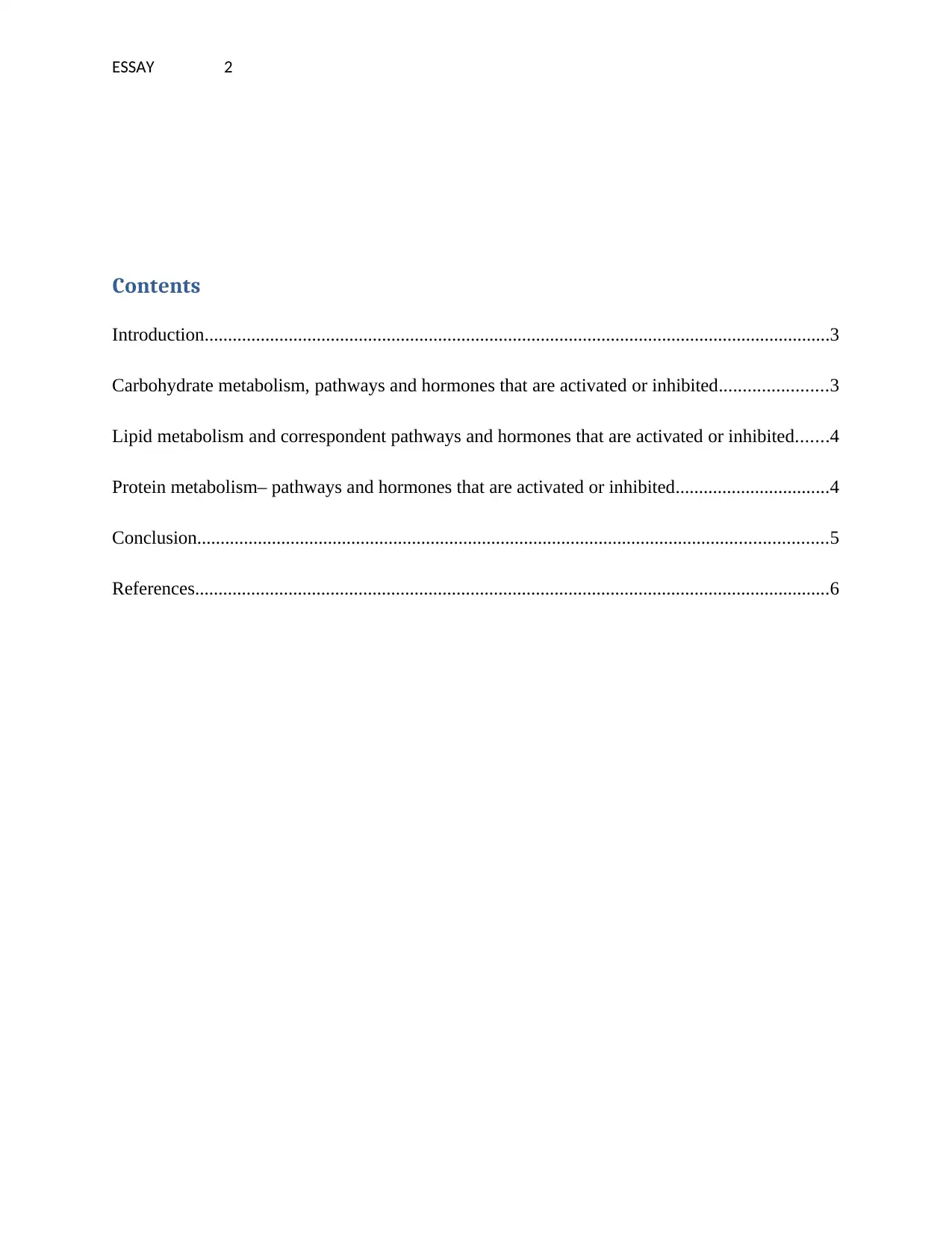
ESSAY 2
Contents
Introduction......................................................................................................................................3
Carbohydrate metabolism, pathways and hormones that are activated or inhibited.......................3
Lipid metabolism and correspondent pathways and hormones that are activated or inhibited.......4
Protein metabolism– pathways and hormones that are activated or inhibited.................................4
Conclusion.......................................................................................................................................5
References........................................................................................................................................6
Contents
Introduction......................................................................................................................................3
Carbohydrate metabolism, pathways and hormones that are activated or inhibited.......................3
Lipid metabolism and correspondent pathways and hormones that are activated or inhibited.......4
Protein metabolism– pathways and hormones that are activated or inhibited.................................4
Conclusion.......................................................................................................................................5
References........................................................................................................................................6
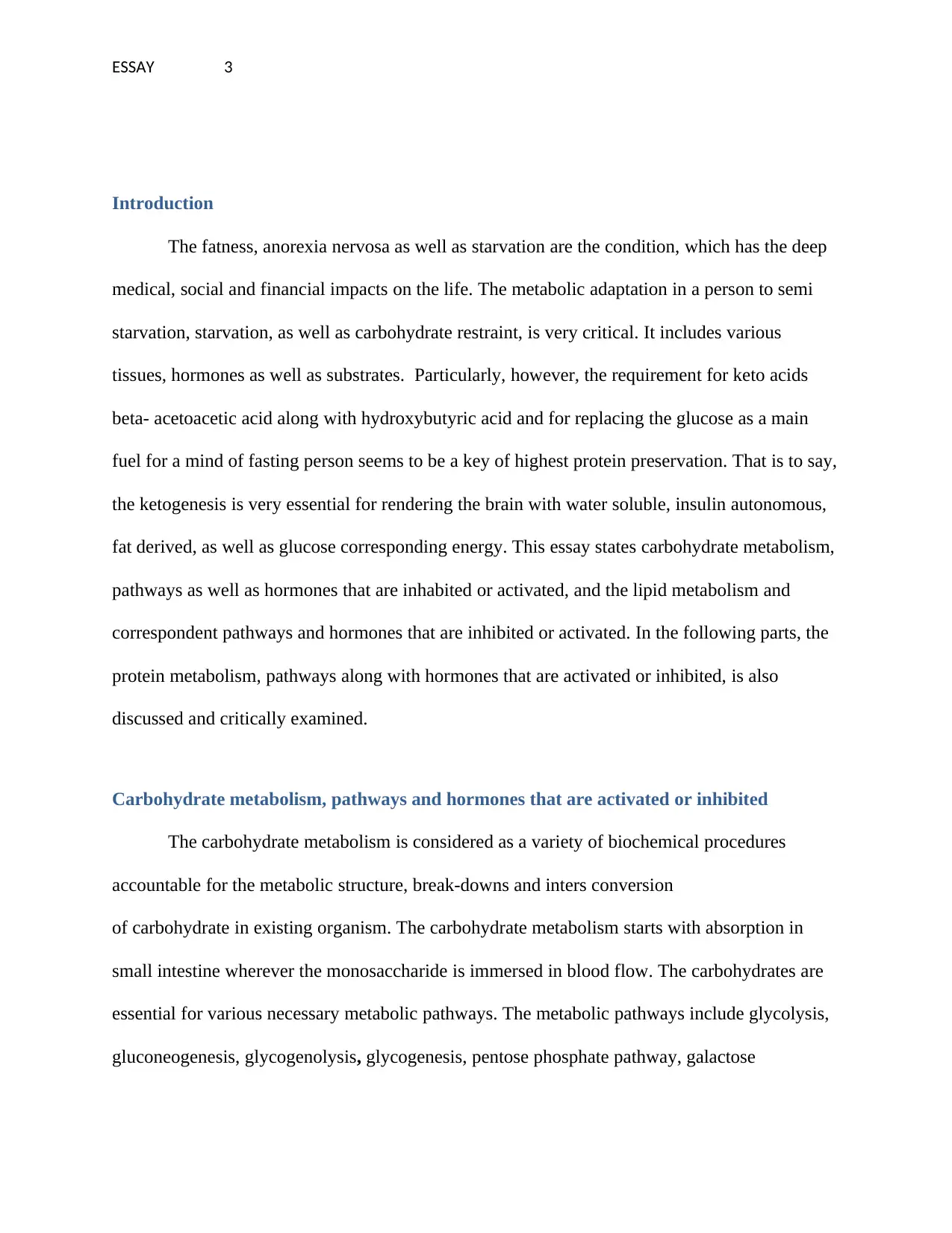
ESSAY 3
Introduction
The fatness, anorexia nervosa as well as starvation are the condition, which has the deep
medical, social and financial impacts on the life. The metabolic adaptation in a person to semi
starvation, starvation, as well as carbohydrate restraint, is very critical. It includes various
tissues, hormones as well as substrates. Particularly, however, the requirement for keto acids
beta- acetoacetic acid along with hydroxybutyric acid and for replacing the glucose as a main
fuel for a mind of fasting person seems to be a key of highest protein preservation. That is to say,
the ketogenesis is very essential for rendering the brain with water soluble, insulin autonomous,
fat derived, as well as glucose corresponding energy. This essay states carbohydrate metabolism,
pathways as well as hormones that are inhabited or activated, and the lipid metabolism and
correspondent pathways and hormones that are inhibited or activated. In the following parts, the
protein metabolism, pathways along with hormones that are activated or inhibited, is also
discussed and critically examined.
Carbohydrate metabolism, pathways and hormones that are activated or inhibited
The carbohydrate metabolism is considered as a variety of biochemical procedures
accountable for the metabolic structure, break-downs and inters conversion
of carbohydrate in existing organism. The carbohydrate metabolism starts with absorption in
small intestine wherever the monosaccharide is immersed in blood flow. The carbohydrates are
essential for various necessary metabolic pathways. The metabolic pathways include glycolysis,
gluconeogenesis, glycogenolysis, glycogenesis, pentose phosphate pathway, galactose
Introduction
The fatness, anorexia nervosa as well as starvation are the condition, which has the deep
medical, social and financial impacts on the life. The metabolic adaptation in a person to semi
starvation, starvation, as well as carbohydrate restraint, is very critical. It includes various
tissues, hormones as well as substrates. Particularly, however, the requirement for keto acids
beta- acetoacetic acid along with hydroxybutyric acid and for replacing the glucose as a main
fuel for a mind of fasting person seems to be a key of highest protein preservation. That is to say,
the ketogenesis is very essential for rendering the brain with water soluble, insulin autonomous,
fat derived, as well as glucose corresponding energy. This essay states carbohydrate metabolism,
pathways as well as hormones that are inhabited or activated, and the lipid metabolism and
correspondent pathways and hormones that are inhibited or activated. In the following parts, the
protein metabolism, pathways along with hormones that are activated or inhibited, is also
discussed and critically examined.
Carbohydrate metabolism, pathways and hormones that are activated or inhibited
The carbohydrate metabolism is considered as a variety of biochemical procedures
accountable for the metabolic structure, break-downs and inters conversion
of carbohydrate in existing organism. The carbohydrate metabolism starts with absorption in
small intestine wherever the monosaccharide is immersed in blood flow. The carbohydrates are
essential for various necessary metabolic pathways. The metabolic pathways include glycolysis,
gluconeogenesis, glycogenolysis, glycogenesis, pentose phosphate pathway, galactose
⊘ This is a preview!⊘
Do you want full access?
Subscribe today to unlock all pages.

Trusted by 1+ million students worldwide
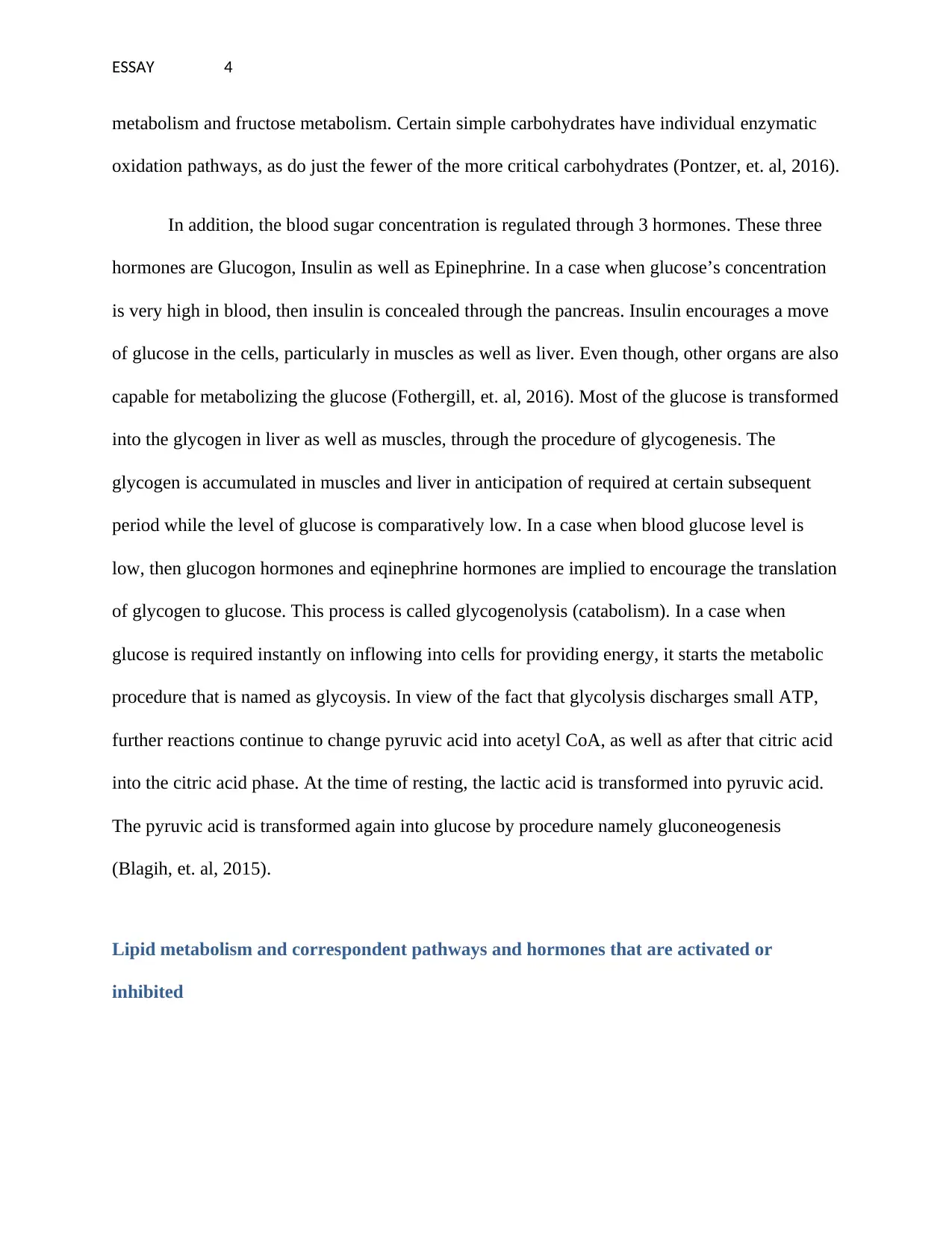
ESSAY 4
metabolism and fructose metabolism. Certain simple carbohydrates have individual enzymatic
oxidation pathways, as do just the fewer of the more critical carbohydrates (Pontzer, et. al, 2016).
In addition, the blood sugar concentration is regulated through 3 hormones. These three
hormones are Glucogon, Insulin as well as Epinephrine. In a case when glucose’s concentration
is very high in blood, then insulin is concealed through the pancreas. Insulin encourages a move
of glucose in the cells, particularly in muscles as well as liver. Even though, other organs are also
capable for metabolizing the glucose (Fothergill, et. al, 2016). Most of the glucose is transformed
into the glycogen in liver as well as muscles, through the procedure of glycogenesis. The
glycogen is accumulated in muscles and liver in anticipation of required at certain subsequent
period while the level of glucose is comparatively low. In a case when blood glucose level is
low, then glucogon hormones and eqinephrine hormones are implied to encourage the translation
of glycogen to glucose. This process is called glycogenolysis (catabolism). In a case when
glucose is required instantly on inflowing into cells for providing energy, it starts the metabolic
procedure that is named as glycoysis. In view of the fact that glycolysis discharges small ATP,
further reactions continue to change pyruvic acid into acetyl CoA, as well as after that citric acid
into the citric acid phase. At the time of resting, the lactic acid is transformed into pyruvic acid.
The pyruvic acid is transformed again into glucose by procedure namely gluconeogenesis
(Blagih, et. al, 2015).
Lipid metabolism and correspondent pathways and hormones that are activated or
inhibited
metabolism and fructose metabolism. Certain simple carbohydrates have individual enzymatic
oxidation pathways, as do just the fewer of the more critical carbohydrates (Pontzer, et. al, 2016).
In addition, the blood sugar concentration is regulated through 3 hormones. These three
hormones are Glucogon, Insulin as well as Epinephrine. In a case when glucose’s concentration
is very high in blood, then insulin is concealed through the pancreas. Insulin encourages a move
of glucose in the cells, particularly in muscles as well as liver. Even though, other organs are also
capable for metabolizing the glucose (Fothergill, et. al, 2016). Most of the glucose is transformed
into the glycogen in liver as well as muscles, through the procedure of glycogenesis. The
glycogen is accumulated in muscles and liver in anticipation of required at certain subsequent
period while the level of glucose is comparatively low. In a case when blood glucose level is
low, then glucogon hormones and eqinephrine hormones are implied to encourage the translation
of glycogen to glucose. This process is called glycogenolysis (catabolism). In a case when
glucose is required instantly on inflowing into cells for providing energy, it starts the metabolic
procedure that is named as glycoysis. In view of the fact that glycolysis discharges small ATP,
further reactions continue to change pyruvic acid into acetyl CoA, as well as after that citric acid
into the citric acid phase. At the time of resting, the lactic acid is transformed into pyruvic acid.
The pyruvic acid is transformed again into glucose by procedure namely gluconeogenesis
(Blagih, et. al, 2015).
Lipid metabolism and correspondent pathways and hormones that are activated or
inhibited
Paraphrase This Document
Need a fresh take? Get an instant paraphrase of this document with our AI Paraphraser
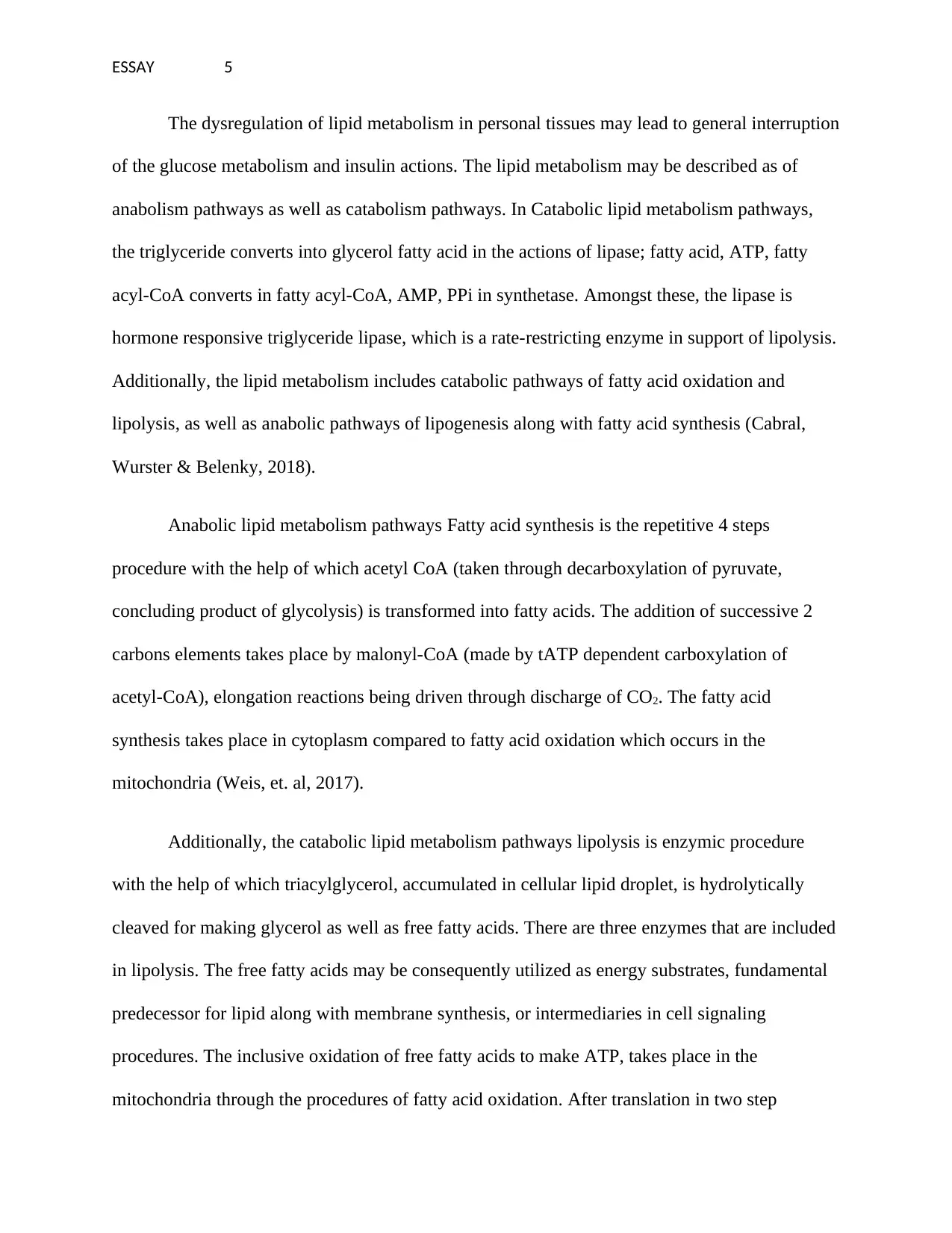
ESSAY 5
The dysregulation of lipid metabolism in personal tissues may lead to general interruption
of the glucose metabolism and insulin actions. The lipid metabolism may be described as of
anabolism pathways as well as catabolism pathways. In Catabolic lipid metabolism pathways,
the triglyceride converts into glycerol fatty acid in the actions of lipase; fatty acid, ATP, fatty
acyl-CoA converts in fatty acyl-CoA, AMP, PPi in synthetase. Amongst these, the lipase is
hormone responsive triglyceride lipase, which is a rate-restricting enzyme in support of lipolysis.
Additionally, the lipid metabolism includes catabolic pathways of fatty acid oxidation and
lipolysis, as well as anabolic pathways of lipogenesis along with fatty acid synthesis (Cabral,
Wurster & Belenky, 2018).
Anabolic lipid metabolism pathways Fatty acid synthesis is the repetitive 4 steps
procedure with the help of which acetyl CoA (taken through decarboxylation of pyruvate,
concluding product of glycolysis) is transformed into fatty acids. The addition of successive 2
carbons elements takes place by malonyl-CoA (made by tATP dependent carboxylation of
acetyl-CoA), elongation reactions being driven through discharge of CO2. The fatty acid
synthesis takes place in cytoplasm compared to fatty acid oxidation which occurs in the
mitochondria (Weis, et. al, 2017).
Additionally, the catabolic lipid metabolism pathways lipolysis is enzymic procedure
with the help of which triacylglycerol, accumulated in cellular lipid droplet, is hydrolytically
cleaved for making glycerol as well as free fatty acids. There are three enzymes that are included
in lipolysis. The free fatty acids may be consequently utilized as energy substrates, fundamental
predecessor for lipid along with membrane synthesis, or intermediaries in cell signaling
procedures. The inclusive oxidation of free fatty acids to make ATP, takes place in the
mitochondria through the procedures of fatty acid oxidation. After translation in two step
The dysregulation of lipid metabolism in personal tissues may lead to general interruption
of the glucose metabolism and insulin actions. The lipid metabolism may be described as of
anabolism pathways as well as catabolism pathways. In Catabolic lipid metabolism pathways,
the triglyceride converts into glycerol fatty acid in the actions of lipase; fatty acid, ATP, fatty
acyl-CoA converts in fatty acyl-CoA, AMP, PPi in synthetase. Amongst these, the lipase is
hormone responsive triglyceride lipase, which is a rate-restricting enzyme in support of lipolysis.
Additionally, the lipid metabolism includes catabolic pathways of fatty acid oxidation and
lipolysis, as well as anabolic pathways of lipogenesis along with fatty acid synthesis (Cabral,
Wurster & Belenky, 2018).
Anabolic lipid metabolism pathways Fatty acid synthesis is the repetitive 4 steps
procedure with the help of which acetyl CoA (taken through decarboxylation of pyruvate,
concluding product of glycolysis) is transformed into fatty acids. The addition of successive 2
carbons elements takes place by malonyl-CoA (made by tATP dependent carboxylation of
acetyl-CoA), elongation reactions being driven through discharge of CO2. The fatty acid
synthesis takes place in cytoplasm compared to fatty acid oxidation which occurs in the
mitochondria (Weis, et. al, 2017).
Additionally, the catabolic lipid metabolism pathways lipolysis is enzymic procedure
with the help of which triacylglycerol, accumulated in cellular lipid droplet, is hydrolytically
cleaved for making glycerol as well as free fatty acids. There are three enzymes that are included
in lipolysis. The free fatty acids may be consequently utilized as energy substrates, fundamental
predecessor for lipid along with membrane synthesis, or intermediaries in cell signaling
procedures. The inclusive oxidation of free fatty acids to make ATP, takes place in the
mitochondria through the procedures of fatty acid oxidation. After translation in two step
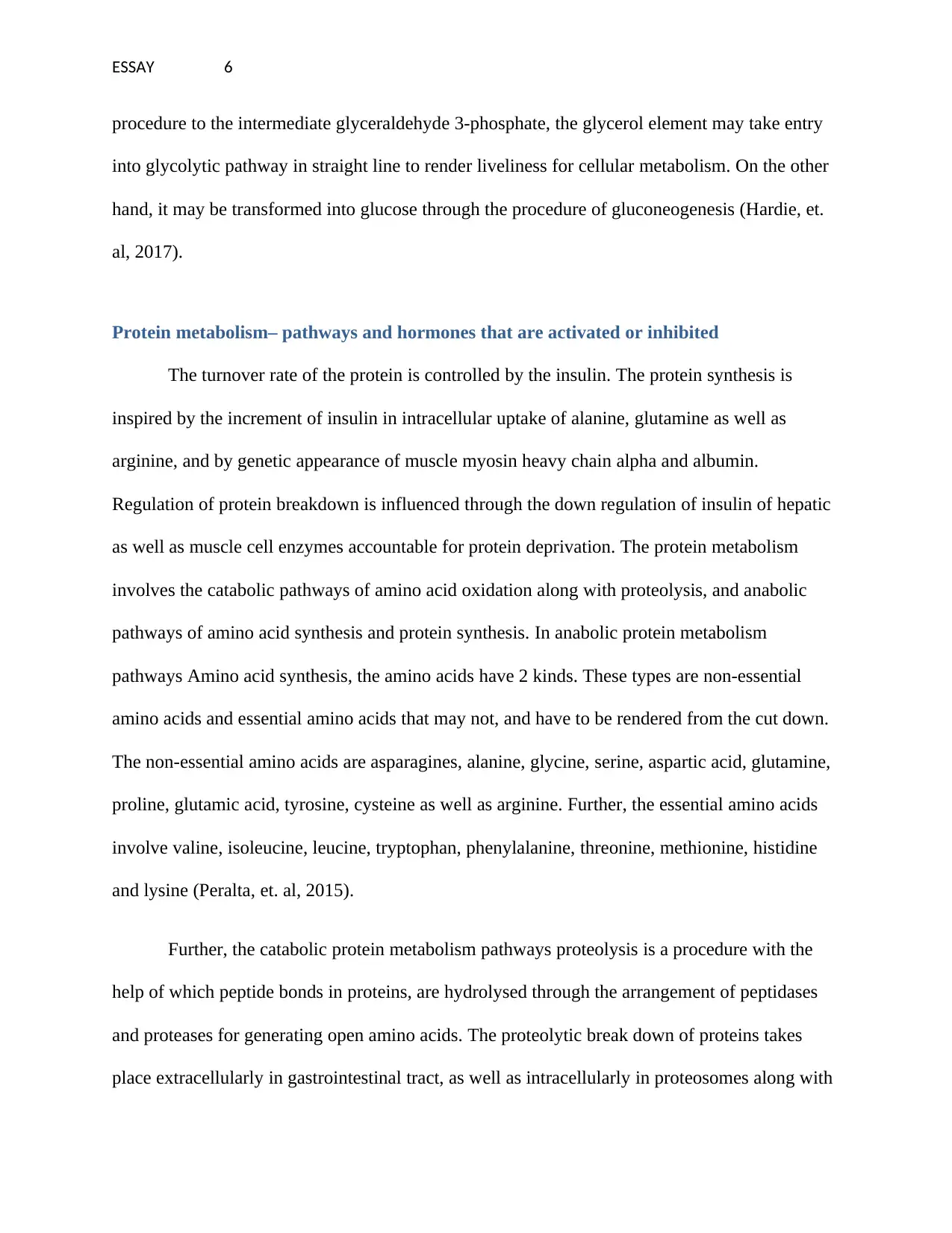
ESSAY 6
procedure to the intermediate glyceraldehyde 3-phosphate, the glycerol element may take entry
into glycolytic pathway in straight line to render liveliness for cellular metabolism. On the other
hand, it may be transformed into glucose through the procedure of gluconeogenesis (Hardie, et.
al, 2017).
Protein metabolism– pathways and hormones that are activated or inhibited
The turnover rate of the protein is controlled by the insulin. The protein synthesis is
inspired by the increment of insulin in intracellular uptake of alanine, glutamine as well as
arginine, and by genetic appearance of muscle myosin heavy chain alpha and albumin.
Regulation of protein breakdown is influenced through the down regulation of insulin of hepatic
as well as muscle cell enzymes accountable for protein deprivation. The protein metabolism
involves the catabolic pathways of amino acid oxidation along with proteolysis, and anabolic
pathways of amino acid synthesis and protein synthesis. In anabolic protein metabolism
pathways Amino acid synthesis, the amino acids have 2 kinds. These types are non-essential
amino acids and essential amino acids that may not, and have to be rendered from the cut down.
The non-essential amino acids are asparagines, alanine, glycine, serine, aspartic acid, glutamine,
proline, glutamic acid, tyrosine, cysteine as well as arginine. Further, the essential amino acids
involve valine, isoleucine, leucine, tryptophan, phenylalanine, threonine, methionine, histidine
and lysine (Peralta, et. al, 2015).
Further, the catabolic protein metabolism pathways proteolysis is a procedure with the
help of which peptide bonds in proteins, are hydrolysed through the arrangement of peptidases
and proteases for generating open amino acids. The proteolytic break down of proteins takes
place extracellularly in gastrointestinal tract, as well as intracellularly in proteosomes along with
procedure to the intermediate glyceraldehyde 3-phosphate, the glycerol element may take entry
into glycolytic pathway in straight line to render liveliness for cellular metabolism. On the other
hand, it may be transformed into glucose through the procedure of gluconeogenesis (Hardie, et.
al, 2017).
Protein metabolism– pathways and hormones that are activated or inhibited
The turnover rate of the protein is controlled by the insulin. The protein synthesis is
inspired by the increment of insulin in intracellular uptake of alanine, glutamine as well as
arginine, and by genetic appearance of muscle myosin heavy chain alpha and albumin.
Regulation of protein breakdown is influenced through the down regulation of insulin of hepatic
as well as muscle cell enzymes accountable for protein deprivation. The protein metabolism
involves the catabolic pathways of amino acid oxidation along with proteolysis, and anabolic
pathways of amino acid synthesis and protein synthesis. In anabolic protein metabolism
pathways Amino acid synthesis, the amino acids have 2 kinds. These types are non-essential
amino acids and essential amino acids that may not, and have to be rendered from the cut down.
The non-essential amino acids are asparagines, alanine, glycine, serine, aspartic acid, glutamine,
proline, glutamic acid, tyrosine, cysteine as well as arginine. Further, the essential amino acids
involve valine, isoleucine, leucine, tryptophan, phenylalanine, threonine, methionine, histidine
and lysine (Peralta, et. al, 2015).
Further, the catabolic protein metabolism pathways proteolysis is a procedure with the
help of which peptide bonds in proteins, are hydrolysed through the arrangement of peptidases
and proteases for generating open amino acids. The proteolytic break down of proteins takes
place extracellularly in gastrointestinal tract, as well as intracellularly in proteosomes along with
⊘ This is a preview!⊘
Do you want full access?
Subscribe today to unlock all pages.

Trusted by 1+ million students worldwide
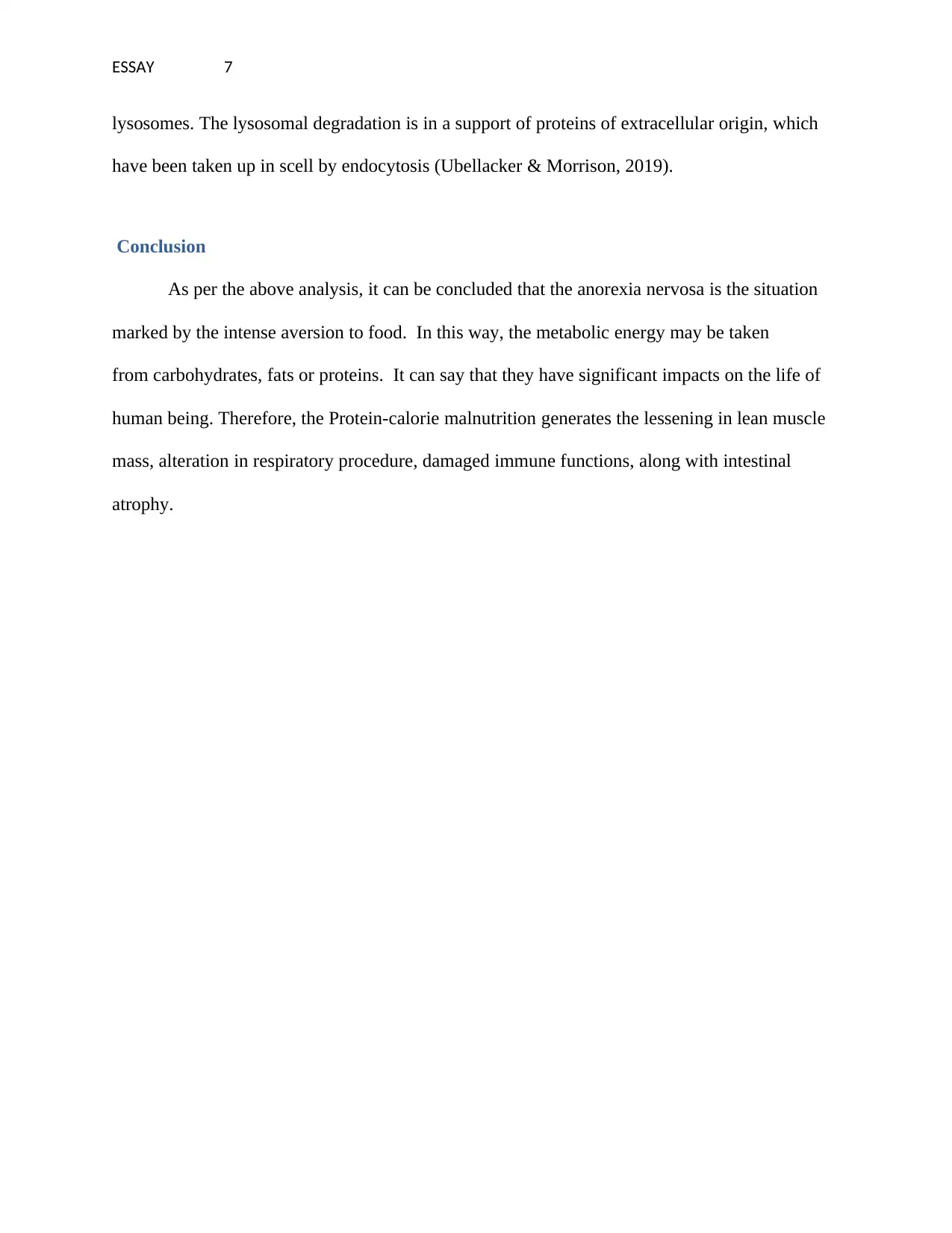
ESSAY 7
lysosomes. The lysosomal degradation is in a support of proteins of extracellular origin, which
have been taken up in scell by endocytosis (Ubellacker & Morrison, 2019).
Conclusion
As per the above analysis, it can be concluded that the anorexia nervosa is the situation
marked by the intense aversion to food. In this way, the metabolic energy may be taken
from carbohydrates, fats or proteins. It can say that they have significant impacts on the life of
human being. Therefore, the Protein-calorie malnutrition generates the lessening in lean muscle
mass, alteration in respiratory procedure, damaged immune functions, along with intestinal
atrophy.
lysosomes. The lysosomal degradation is in a support of proteins of extracellular origin, which
have been taken up in scell by endocytosis (Ubellacker & Morrison, 2019).
Conclusion
As per the above analysis, it can be concluded that the anorexia nervosa is the situation
marked by the intense aversion to food. In this way, the metabolic energy may be taken
from carbohydrates, fats or proteins. It can say that they have significant impacts on the life of
human being. Therefore, the Protein-calorie malnutrition generates the lessening in lean muscle
mass, alteration in respiratory procedure, damaged immune functions, along with intestinal
atrophy.
Paraphrase This Document
Need a fresh take? Get an instant paraphrase of this document with our AI Paraphraser

ESSAY 8
References
Blagih, J., Coulombe, F., Vincent, E. E., Dupuy, F., Galicia-Vázquez, G., Yurchenko, E. &
Pelletier, J. (2015). The energy sensor AMPK regulates T cell metabolic adaptation and
effector responses in vivo. Immunity, 42(1), 41-54.
Cabral, D., Wurster, J., & Belenky, P. (2018). Antibiotic persistence as a metabolic adaptation:
stress, metabolism, the host, and new directions. Pharmaceuticals, 11(1), 14
Eales, K. L., Hollinshead, K. E. R., & Tennant, D. A. (2016). Hypoxia and metabolic adaptation
of cancer cells. Oncogenesis, 5(1), e190.
Fothergill, E., Guo, J., Howard, L., Kerns, J. C., Knuth, N. D., Brychta, R., ... & Hall, K. D.
(2016). Persistent metabolic adaptation 6 years after “The Biggest Loser”
competition. Obesity, 24(8), 1612-1619.
Hardie, R. A., Van Dam, E., Cowley, M., Han, T. L., Balaban, S., Pajic, M. & Miller, D. (2017).
Mitochondrial mutations and metabolic adaptation in pancreatic cancer. Cancer &
metabolism, 5(1), 2.
Peralta, D., Bronowska, A. K., Morgan, B., Dóka, É., Van Laer, K., Nagy, P.& Dick, T. P.
(2015). A proton relay enhances H 2 O 2 sensitivity of GAPDH to facilitate metabolic
adaptation. Nature chemical biology, 11(2), 156
References
Blagih, J., Coulombe, F., Vincent, E. E., Dupuy, F., Galicia-Vázquez, G., Yurchenko, E. &
Pelletier, J. (2015). The energy sensor AMPK regulates T cell metabolic adaptation and
effector responses in vivo. Immunity, 42(1), 41-54.
Cabral, D., Wurster, J., & Belenky, P. (2018). Antibiotic persistence as a metabolic adaptation:
stress, metabolism, the host, and new directions. Pharmaceuticals, 11(1), 14
Eales, K. L., Hollinshead, K. E. R., & Tennant, D. A. (2016). Hypoxia and metabolic adaptation
of cancer cells. Oncogenesis, 5(1), e190.
Fothergill, E., Guo, J., Howard, L., Kerns, J. C., Knuth, N. D., Brychta, R., ... & Hall, K. D.
(2016). Persistent metabolic adaptation 6 years after “The Biggest Loser”
competition. Obesity, 24(8), 1612-1619.
Hardie, R. A., Van Dam, E., Cowley, M., Han, T. L., Balaban, S., Pajic, M. & Miller, D. (2017).
Mitochondrial mutations and metabolic adaptation in pancreatic cancer. Cancer &
metabolism, 5(1), 2.
Peralta, D., Bronowska, A. K., Morgan, B., Dóka, É., Van Laer, K., Nagy, P.& Dick, T. P.
(2015). A proton relay enhances H 2 O 2 sensitivity of GAPDH to facilitate metabolic
adaptation. Nature chemical biology, 11(2), 156

ESSAY 9
Pontzer, H., Durazo-Arvizu, R., Dugas, L. R., Plange-Rhule, J., Bovet, P., Forrester, T. E. &
Luke, A. (2016). Constrained total energy expenditure and metabolic adaptation to
physical activity in adult humans. Current Biology, 26(3), 410-417.
Ubellacker, J. M., & Morrison, S. J. (2019). Metabolic Adaptation Fuels Lymph Node
Metastasis. Cell metabolism, 29(4), 785-786.
Weis, S., Carlos, A. R., Moita, M. R., Singh, S., Blankenhaus, B., Cardoso, S., & Mithieux, G.
(2017). Metabolic adaptation establishes disease tolerance to sepsis. Cell, 169(7), 1263-
1275.
Pontzer, H., Durazo-Arvizu, R., Dugas, L. R., Plange-Rhule, J., Bovet, P., Forrester, T. E. &
Luke, A. (2016). Constrained total energy expenditure and metabolic adaptation to
physical activity in adult humans. Current Biology, 26(3), 410-417.
Ubellacker, J. M., & Morrison, S. J. (2019). Metabolic Adaptation Fuels Lymph Node
Metastasis. Cell metabolism, 29(4), 785-786.
Weis, S., Carlos, A. R., Moita, M. R., Singh, S., Blankenhaus, B., Cardoso, S., & Mithieux, G.
(2017). Metabolic adaptation establishes disease tolerance to sepsis. Cell, 169(7), 1263-
1275.
⊘ This is a preview!⊘
Do you want full access?
Subscribe today to unlock all pages.

Trusted by 1+ million students worldwide
1 out of 9
Related Documents
Your All-in-One AI-Powered Toolkit for Academic Success.
+13062052269
info@desklib.com
Available 24*7 on WhatsApp / Email
![[object Object]](/_next/static/media/star-bottom.7253800d.svg)
Unlock your academic potential
Copyright © 2020–2025 A2Z Services. All Rights Reserved. Developed and managed by ZUCOL.





